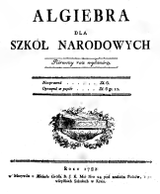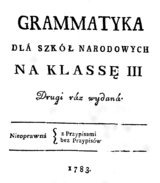Commission of National Education
The Commission of National Education (Polish: Komisja Edukacji Narodowej, KEN; Lithuanian: Edukacinė komisija) was the central educational authority in the Polish–Lithuanian Commonwealth, created by the Sejm and King Stanisław II August on October 14, 1773. Because of its vast authority and autonomy, it is considered the first education ministry in European history and an important achievement of the Polish Enlightenment.[1][2]
History


Genesis
The chief reason behind its creation was that in Poland and
One of the first items on the parliamentary agenda of the Partition Sejm (1773–1775), which acceded to the First Partition of Poland, was the assessment in how to best utilise the former Jesuit property and declaration of a firm intention to the continuity of the education system.[3]
The Commission was formally created on October 14, 1773.
Despite the fact that, initially, the KEN had to face a strong opposition in the
Early (formative) period (1773–1780)
In 1773 the KEN was granted much of the former property of the
The Commission supervised two universities (
Soon afterwards Hugo Kołłątaj prepared a three-level-based education plan:
- Parochial schools – for peasants and burghers;
- Powiat schools – mostly for children of the szlachta (nobility); however, children of lower classes were also admitted;
- Universities – Academy of Warsaw, Academy of Vilnius and Academy of Kraków
Since all prior education in the Polish–Lithuanian Commonwealth was conducted mostly in
The Commission also devised several documents, outlining the whole educational process. However, several of the new principles were considered too novel for that age, and were often ignored. These included, inter alia, the principle of 'equality of both sexes' in education. In 1780, the Opposition refused to sign the Statute on Elementary Schools (which was drafted by Kołłątaj).
In 1774 the Commission took over the Załuski Library.
-
Algebra for national schools, (1782).
-
Elementary book, (1785).
-
Krzysztof Kluk, Botanics for national schools, (1785).
-
Michał Jan Hube, Physics for national schools (1792).
-
Onufry Kopczyński, The layout of Grammatics for national schools, (1785).
-
Grammatics for national schools, (1783).
-
Introduction to physics for national schools, (1788).
Second phase (1781–1788)
After the formative period, during which the prerogatives of the Commission were established, the KEN started to convert schools to the new model. The three universities in Warsaw, Vilnius and Kraków were granted the right of curatorship over schools of lower degree. This included the schools which remained under the influence of the Roman Church. Gradually, the teachers, who were frequently former Jesuit priests, were exchanged for young lay teachers - graduates of the three academies. Thanks to this move, the opposition inside the local schools was finally broken.
Third phase (1788–1794)

After 1789 the supporters of reforms in the Polish
Legacy
This section needs additional citations for verification. (October 2011) |
Although the Commission had only functioned for around 20 years, it managed to completely change the shape of education in Poland. The
It is often argued, with quite some force, that because of the efforts of the Commission of National Education, the Polish language and culture did not disappear into oblivion, during the Partitions of Poland – heavy Russification and Germanisation notwithstanding.
Members
Members of Commission of National Education were:[4]
| Member | Other posts | Time of membership | Notes |
|---|---|---|---|
Ignacy Massalski |
Bishop of Vilnius | 1773–1792 | President until 1786 |
Michał Poniatowski |
Primate of Poland (from 1784) |
1773–1792 | President from 1786 |
| August Sułkowski | Voivode of Poznań |
1773–1786 | |
| Joachim Chreptowicz | Deputy Chancellor of Lithuania, PLC minister of foreign affairs (from 1791) |
1773–1786 | |
| Ignacy Potocki | Grand Marshal of Lithuania, PLC minister of police (from 1791) |
1773–1791 | |
| Adam Kazimierz Czartoryski | General Starosta of Podolia, Commander of Cadet Corps | 1773–1792 | |
Andrzej Zamoyski |
former Great Chancellor of the Crown |
1773–1783 | |
| Antoni Poniński | Starosta of Kopanica | 1773–1777 | |
| Andrzej Mokronowski | general inspector, Voivode of Mazovia (from 1781) | 1776–1784 | |
| Jacek Małachowski | Deputy Chancellor the Crown |
1776–1783 | |
| Franciszek Bieliński | Starosta of Czersk | 1776–1783 | |
| Stanisław Poniatowski | Grand Treasurer of Lithuania (1784–1790) |
1776–1792 | |
| Michał Mniszech | Grand Marshal of the Crown (from 1783) |
1777–1783 | replaced A. Poniński |
Szczęsny Potocki |
Voivode of Ruthenia, General of Artillery of the Crown |
1783–1792 | replaced J. Małachowski |
| Maciej Garnysz | Deputy Chancellor the Crown |
1783–1790 | replaced F. Bieliński |
| Antoni Małachowski | Grand Clerk of the Crown, Voivode of Mazovia | 1783–1792 | replaced A. Zamoyski |
| Michał Radziwiłł | Castellan of Vilnius, Voivode of Vilnius | 1783–1792 | replaced M. Mniszech |
| Ignacy Przebendowski | Starosta of Soleck | 1785–1791 | replaced A. Mokronowski |
| Feliks Oraczewski | 1786–1792 | ||
| Kacper Cieciszowski | Bishop of Kiev |
1791–1792 | replaced M. Garnysz |
| Antoni Lanckoroński | 1791–1792 | three together replaced J. Chreptowicz, I. Potocki and I. Przebendowski | |
| Julian Ursyn Niemcewicz | 1791–1792 | three together replaced J. Chreptowicz, I. Potocki and I. Przebendowski | |
| Ludwik Gutakowski | 1791–1792 | three together replaced J. Chreptowicz, I. Potocki and I. Przebendowski |
Notes
- ISBN 978-0-415-35491-2. Retrieved 17 March 2013.
- ISBN 978-0-231-12819-3. Retrieved 17 March 2013.
- ^ ISBN 978-0-7818-0637-4. Retrieved 13 August 2011.
- ^ Waldemar Firlej, Danuta Krześniak-Firlej, "Komisja Edukacji Narodowej (1773–1794) – w 240. rocznicę utworzenia KEN" // "Studia Pedagogiczne. Problemy Społeczne, Edukacyjne i Artystyczne", 2014, issue 24, p. 39-65 [1]
Further reading
- Gorecki, Danuta M. "The Commission of National Education and Civic Revival through Books in Eighteenth-Century Poland." Journal of Library History 15.2 (1980): 138-166.







